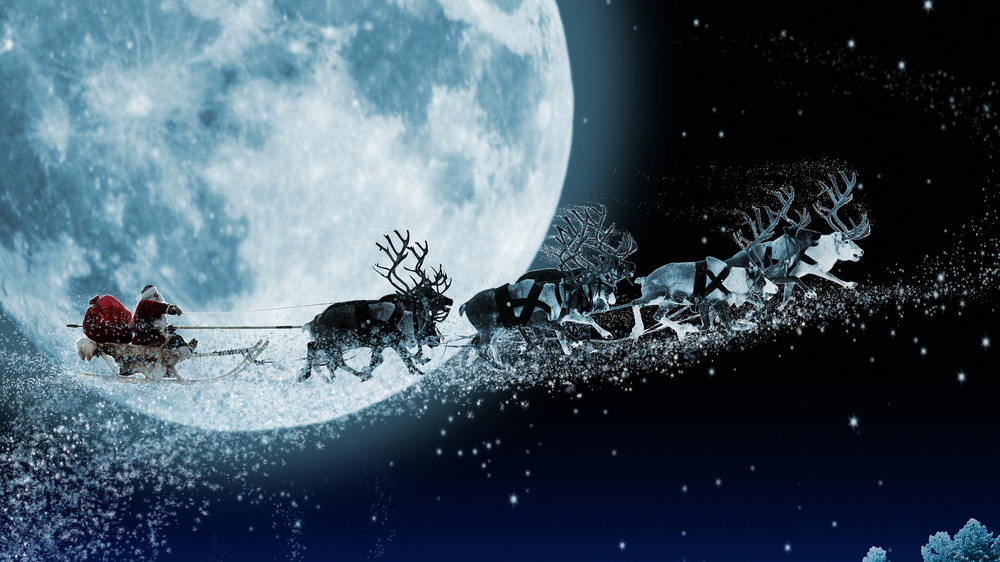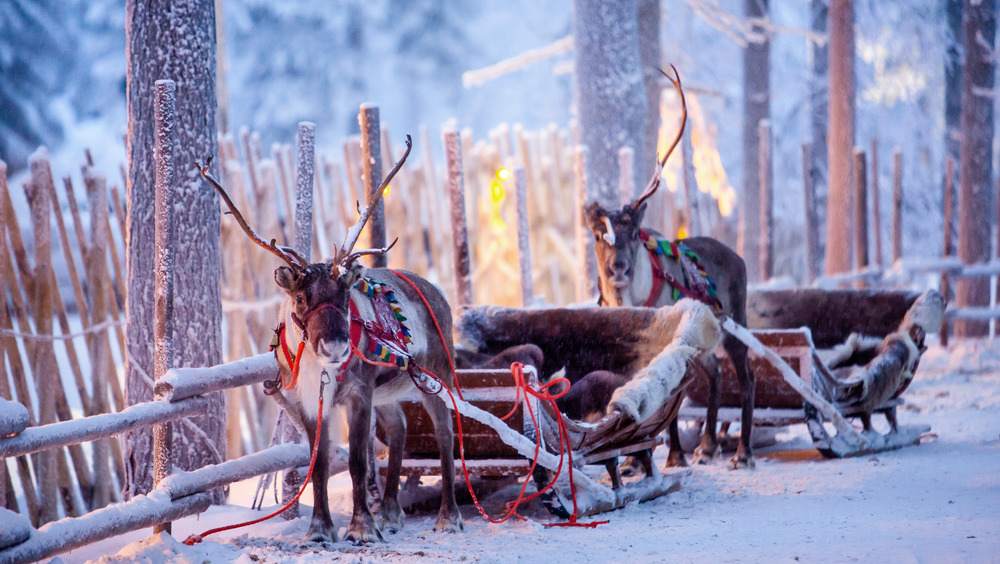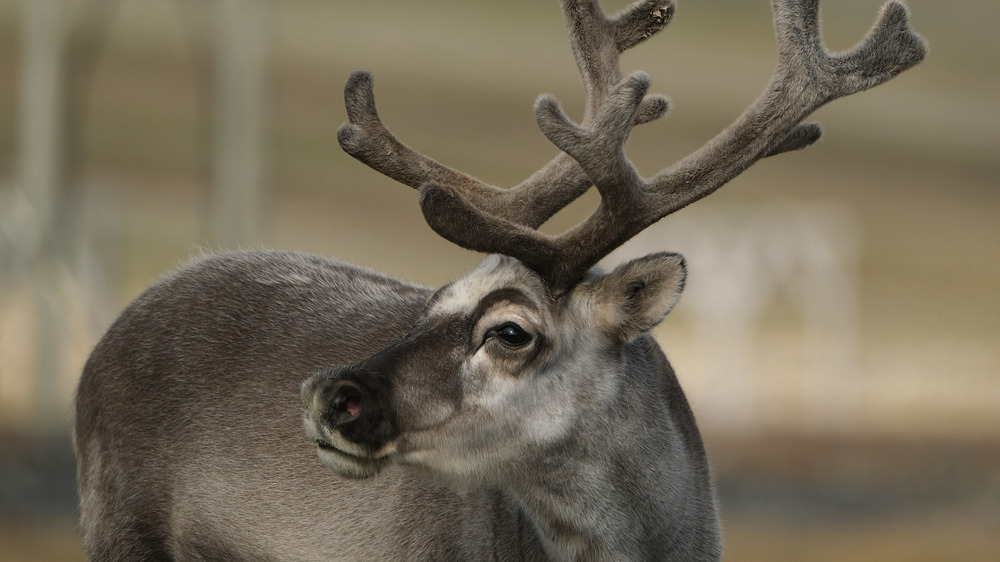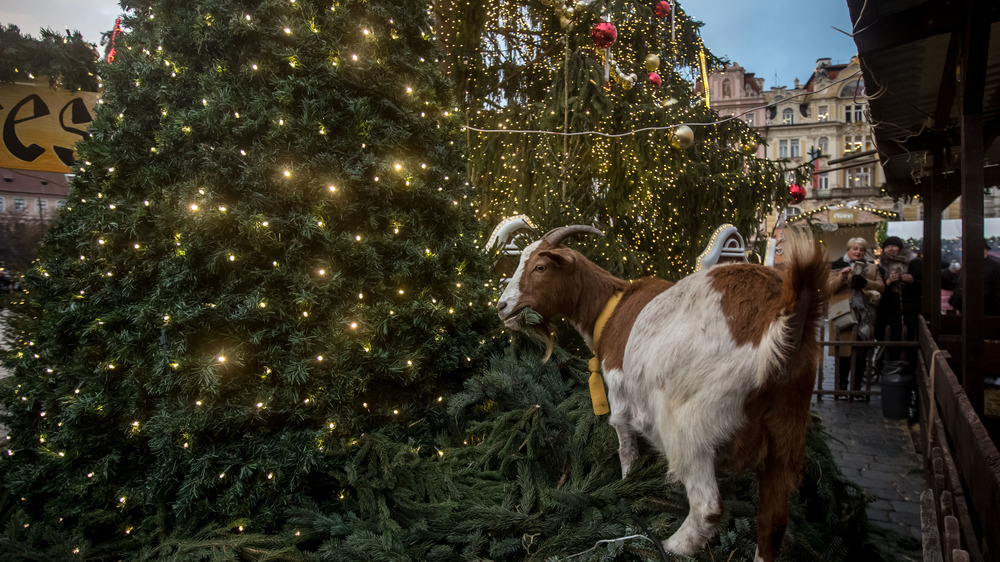What Do Reindeer Have To Do With Christmas?
Christmas Eve is a time of magic and suspense for children around the world. The tree is up and decorated (surely no sooner than the day after Thanksgiving), lights have been strung, and dads everywhere have spent too much time and money trying to one-up their neighbors' yard decorations. Milk and cookies are set out near the fireplace for any mystical visitor who may be stopping by. After all, you're hoping anything will buy you a ticket onto the "nice list" after that thing you did back in April. There's only one thing left to do: listen for Santa Claus's iconic sleigh bells.
Was that the sounds of hooves on the roof? Is Old Saint Nick here with his magical flying reindeer? That whole image, that possibility, does make us wonder. Santa could just as easily have used horses or some other speedy creature, but reindeer have become such an important part of the jolly saint's modern-day image that it would be hard to imagine him without them. Those reindeer had to come from somewhere. So, what the heck do the magical caribou have to do with Christmas?
The reindeer appeared in 1823
In the majority of the legends of Santa Claus and his associates, he doesn't utilize reindeer. He wasn't even associated with the North Pole. He'd show up out of nowhere and drop off some gifts. He didn't need a "how" or a "from where." But all of that changed with one little poem in 1823. According to The Durango Herald, the first mention of Santa's famous reindeer was in Clement Clarke Moore's classic "A Visit from Saint Nicholas" (the full text is posted at the website of the Poetry Foundation). You know the poem:
"'Twas the night before Christmas, when all through the house / not a creature was stirring, not even a mouse."
The poem has shaped our idea of Santa Clause for two centuries and, with it, everything we know about St. Nick's flying cervids, which isn't much. The poem mentions that he has eight "tiny rein-deer" that fly, and it gives us their names when Santa calls them out, but that's about it. The legend of how the reindeer got their flying powers, via magical corn, was mentioned a century and a half later with the 1970 stop motion film Santa Claus Is Comin' to Town.
As for Rudolph ... Well, Rudolph wasn't a thing until 1939, and his fame is more capitalistic than whimsical. Originally a character from a Montgomery Ward department store coloring book, Rudolph and the rest of Santa's reindeer gained their modern popularity through a clever marketing scheme.
The reindeer myth was perpetuated as a marketing ploy
Though Santa Claus's reindeer began with a bit of fanciful pre-Victorian literature, their rise in popularity correlates strongly with the changes we've seen in Christmas over the decades. The holiday has become saturated with commercialization, consumerism, and commerce. Sure, we still spend the time with family, and many celebrate with religious intent, but it would be hard to deny that the importance of gift-giving and visits to Santa in department stores isn't meant to channel our cash into the economy. Santa's reindeer aren't much different.
Reindeer began to be grown as a food source in Alaska by the late 1800s, and in the 1920s, a businessman named Carl Lomen decided he could capitalize on the commercial reindeer meat and fur markets with a clever marketing ploy. He just needed to make reindeer famous first. He teamed up with Macy's department store, according to CNN, and together they started a parade led by Santa and his reindeer. Lomen took things a step further and began to publish fraudulent letters in newspapers, posing as children begging for Santa to bring his reindeer to their towns. The parades caught on throughout the United States, and the industry began to boom. Lomen Reindeer Co.'s empire died in 1937 with the passing of laws that prohibited non-indigenous people from owning reindeer, but not before cementing Santa's reindeer in Christmas history forever and the creation of a new reindeer: Rudolph.
They were supposed to be goats
Here's the thing about Santa's reindeer: They weren't supposed to be reindeer at all. It's generally believed that when Clement Clarke Moore wrote about Santa's reindeer, he was drawing inspiration from a couple of mythical creatures from a different sleigh-pulling legend. Santa is conglomeration of multiple myths. He's partly St. Nicholas, partly Norse god, partly Father Christmas — the list goes on. His reindeer, according to The Durango Herald, were most likely based on the Norse god Thor and his helpful, flying helpers, Tanngrisnir and Tanngnjóstr. Which, as you probably already knew, are not reindeer, but giant goats.
Goats were tied to Christmas long before reindeer ever entered the picture. In the town of Gävle, Sweden, they're still associated with the holiday. A giant Yule goat, or Julbock, is erected every year, made of straw and standing over 40 feet in height. The Yule goat, according to CBC, is associated with old Pagan traditions of the Yule holiday and is believed to help in the delivery of presents around the world. It's said that Santa Claus rides the flying Yule goat instead of driving his sleigh. For some reason, it's open season on the straw goat, with people trying (often successfully) to set it on fire. Which seems Christmas-y.
Where goats might not be as pretty as reindeer, they both have their place in the legends of Santa Claus.



